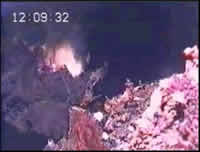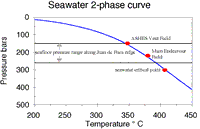| |
| |
 Ashes vent "flaming" due to phase separation. View
the movie from ROV dive.
Ashes vent "flaming" due to phase separation. View
the movie from ROV dive. |
|
Phase
Separation
The process
of phase separation, which takes place either as normal boiling or as
brine condensation at supercritical pressures (see figure below), plays
a crucial role in determining vent fluid composition. Elements are fractionated
between the liquid and vapor phases, with ionic species partitioned into
the liquid phase and volatile species into the vapor phase. Phase separation
may take place under a variety of circumstances. In an aqueous salt solution,
normal boiling (i.e. production of low salinity vapor) occurs when the
fluid crosses the two-phase curve below critical pressure and temperature.
However, if the fluid crosses the two-phase curve at a pressure and temperature
above the critical point, a high-salinity brine condenses out of the fluid.
These two types of phase separation produce very different chemistries.
 A
perfect example of subcritical phase separation in a hydrothermal system
occurs at Axial Volcano. Based on chemical systematics (Butterfield et
al. 1990), a single hydrothermal endmember ascending in an upflow zone
along the caldera-bounding fault decompresses and crosses the two-phase
curve, producing a vapor phase that migrates away from the higher-salinity,
residual liquid phase. Different mixtures (or unmixtures, if you will)
of the vapor and liquid phases exit the seafloor in distinctly different
types of vents . There are different mechanisms that can result in the
vapor phase becoming segregated from the liquid phase; the point is that
it does happen in many hydrothermal systems. A
perfect example of subcritical phase separation in a hydrothermal system
occurs at Axial Volcano. Based on chemical systematics (Butterfield et
al. 1990), a single hydrothermal endmember ascending in an upflow zone
along the caldera-bounding fault decompresses and crosses the two-phase
curve, producing a vapor phase that migrates away from the higher-salinity,
residual liquid phase. Different mixtures (or unmixtures, if you will)
of the vapor and liquid phases exit the seafloor in distinctly different
types of vents . There are different mechanisms that can result in the
vapor phase becoming segregated from the liquid phase; the point is that
it does happen in many hydrothermal systems.
Vent Fluid Chemistry | Circulation Zones
| Fluid-Rock Reaction | Phase Separation| Temporal
Changes | Microbial Biosphere
|
|

